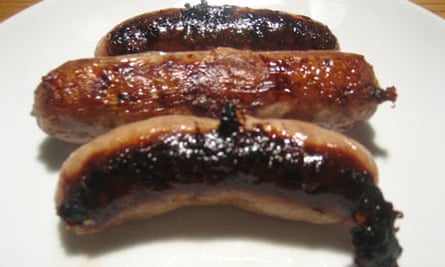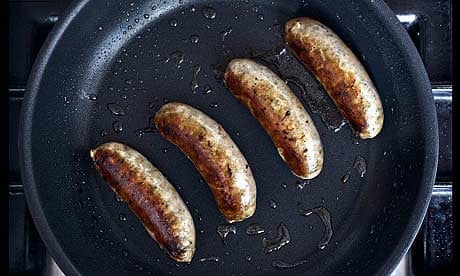Like beer, biscuits, and brave Cheryl Cole, the great British banger is something we, as a nation, can be proud of. Not for us the suspiciously smooth German wurst, or the startlingly sweet Chinese lap cheung: our plump beauties pair serious texture with subtle seasoning – a sun-dried tomato, for example, has no place in a hog casing this far from the Mediterranean. Yet somewhat perplexingly, we're also a people who sincerely believe that stabbing a sausage and shoving it under a hot grill is doing it justice. The 'micro sausage' is the bright pink proof – we're squandering our glorious sausagey heritage out of sheer ignorance.
One relatively recent misconception – as far as I'm concerned, at least – is that the more meat a sausage contains, the better it will taste. While I'm no advocate of those barely legal pallid tubes (minimum meat contents are currently 42% for pork sausages, and an astonishing 30% for other meats; and that includes fat and – sorry – connective tissue), my experience of the all-meat monsters they're so proud of on the continent has also been disappointing: either they're dry or ridiculously greasy.
This highlights an important rule of sausagemaking: there needs to be a good balance of meat and fat. Too much of the former, and the results will lack that vital moistness (as Nigel Slater so wisely observes, there's no joy in a dry sausage), too much of the latter and the sausage will spurt grease like Old Faithful in a chippie – which is where the breadcrumbs in the classic British banger come in. They're not there just to make up the numbers: they soak up the flavoursome fat during cooking, giving a juicier, but less greasy result.
Apparently quite sensible people are devotees of the cult of maximum meat though, so I thought I'd better give it another go. The sausages I usually buy are 87% pork (61% shoulder, and 26% belly): the best I could find on my shopping expedition was 97%, made entirely from pork shoulder, with no 'filler' at all (the other 3% was water, seasoning, preservative and casing, so I assume it would be difficult to go much higher than this). To be fair to these behemoths, I grilled one, and fried the other very, very gently. When sampled alongside the fattier, less meaty bangers, there was no contest: "This is more like some sort of sausage burger," my boyfriend objected. Dense, dry, and aggressively porky, they were not to my taste either, although I am prepared to accept that, had there been more fat in there, the results might at least have been more succulent.
Having proved to my satisfaction that I wasn't on the wrong track with my choice of sausage, I now needed to check I was cooking them right. My mother always presaged death, or at the very least, painful blinding by molten pig fat, for anyone who didn't prick their links before cooking. As every good foodie knows, this is nonsense: rationing ended some time ago, and these days even the cheapest banger is unlikely to contain enough water to actually explode. I gave up the practice after reading Matthew Fort's very persuasive thoughts on the subject in Nigel Slater's Real Food: "You must never, ever, under any circumstances whatsoever, prick a British sausage of any kind of quality. It does not deserve such treatment. If you do prick, you will only allow a good deal of the natural juices to flow out during cooking, making the inside drier and lessening the flavour." John Torode, MasterChef judge and alleged meat fan, is a brave dissenting voice: "Always prick them before frying to let the fat out" he advises, without troubling to explain why you would ever wish to do such a terrible thing to an innocent sausage.

I took four sausages from the same batch, and pricked two of them in the centre. Half went under a medium grill for 15 minutes, and half went into frying pans with a smear of butter on a low heat for 40 minutes as Fort recommends – that's quite a long time, it turns out, when you're lurking around the hob keeping a watchful eye for any escaping juices. Both maimed sausages did indeed leak more liquid, although not as much as I'd expected, but in the pan these solidified around the base of the sausage, creating a deliciously savoury crust which I later snaffled as a cook's perk.

The two grilled sausages were both noticeably more shrivelled than the slow-fried ones, but not appreciably different from each other – if I hadn't known one had been pricked, I doubt I would have observed it was slightly drier. The pan-fried unpricked sausage, meanwhile, was a joy to behold, glossy and plump, with juices bubbling away under the skin as I cut into it. It didn't disappoint on the flavour front either – nicely caramelised on the bottom and moist inside, it beat the other three hands down. The pre-pricked, fried sausage was pretty good too – it just lacked that last unctuous smidgen of juice that would have taken it to the next level. So it looks like the old 'prick with a fork' joke will have to die a natural death – and if you haven't got time to give your sausages a nice slow cooking, then perhaps you should go for pasta instead.
You might think that that was that, but looking online, I'd stumbled across yet another school of thought – the double-cook method. Devotees of Heston Blumenthal swear by this poach and fry combination: according to the man himself 'this gentle cooking helps to keep in the meat's juices'. Like many of the great chef's recipes, it sounded rather more complicated than was strictly necessary, but I reminded myself that if ever a foodstuff merited extra washing up, it was the sausage.

As instructed, I brought a pan of water up to 65˚C, and plopped a couple in for a nice warm soak. After 20 minutes I lifted them out – discovering in the process that there is little less appetising looking than a poached sausage – hastily wiped them, and dropped them into a hot frying pan, which perked them up considerably. Were they a revelation in porky form? No. They were good, but strangely, although just as moist as the slow-fried ones, they seemed less flavoursome somehow, as if some of that delicious fat had leaked out somewhere along the line. Given that they'd required two pans and a cooking thermometer to achieve, and the ends were still an unpleasant grey colour, I decided they weren't really worth the effort.
So, to conclude, for the perfect British sausage experience, choose a banger with a fair proportion of fat to meat, and a few breadcrumbs too, leave it intact, and fry it ever so gently in a pan for 40 minutes while you go off and do something else, like walking the bulldog, enjoying an cask-conditioned ale or visiting a red telephone box.
Do you agree or are you, like John Torode, of the school that likes to drain the fat from your sausages before eating? Is there any such thing as an 100% meat sausage – and if so, is it any good? Do Scots really favour beer sausages – and will anyone admit to preferring them battered?

Comments (…)
Sign in or create your Guardian account to join the discussion